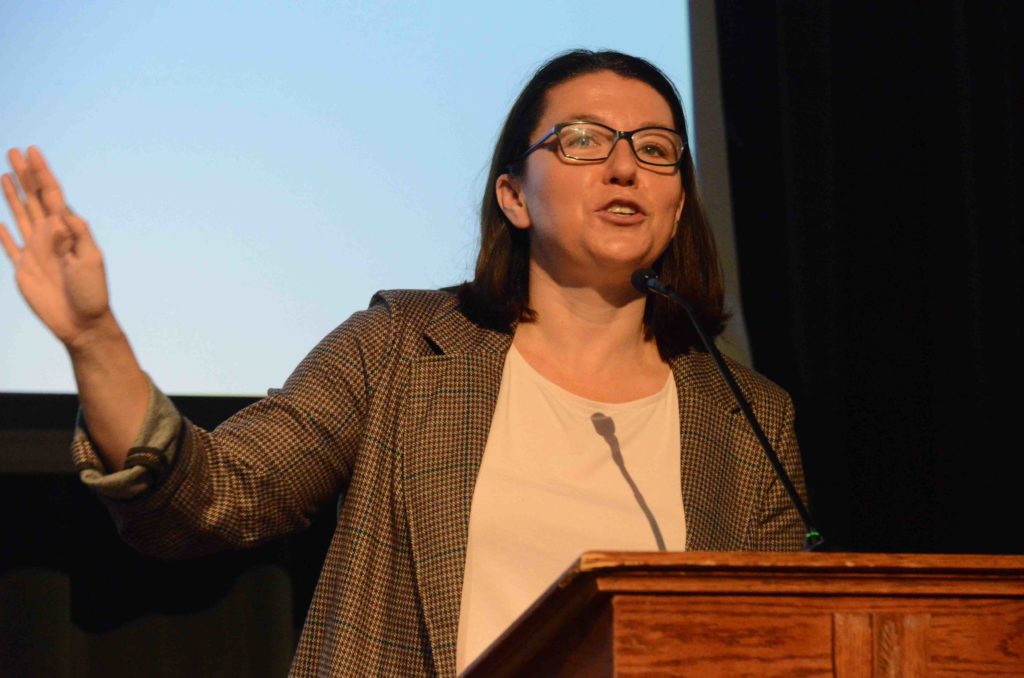The How-Tos of Healthy Digital Engagement: Two Sessions With Dr. Jill Walsh
“People have strong opinions about what technology you should and shouldn’t use, about when and for how long,” began Dr. Jill Walsh in the Smith Theater. “Adults are confused, and so are kids, honestly. The information isn’t clear, and it often contradicts itself.”
Dr. Walsh joined RL students and faculty for two Halls this fall—one on October 27 and a second on December 8—as part of RL’s Health and Wellness series. Dr. Walsh is a sociologist, researcher, and lecturer at Boston University, focused on how social media affects young people’s emotional wellbeing and relationships, in ways both positive and negative.
Over the course of her two sessions, Dr. Walsh shared clear and compelling evidence from recent research that points to how we use technology—and social media, in particular—as a mood moderator, and how too much technological distraction can have significant negative effects.
“Technology is not a monolith—it is neither good nor bad,” she said. “Rather, people’s interactions with technology, and how it affects them, are very personal and individual.” Factors can include an individual’s personality, the time of day, what you see when you’re online, how you’re feeling before you engage, who you’re connecting with, and how much time you’re spending.
“The best thing you can do—and what I’m going to help you do over these two sessions—is make you the expert on your own use of technology. I want you to understand what’s hard for you and what’s easy, what works for you and what doesn’t. Understanding this, and acting accordingly, is an important life skill, because you’re going to be engaging with technology for the rest of your life.”
Dr. Walsh talked about how we often use technology as a mood management tool; we turn to it when we’re feeling bored, nervous, exhausted, stressed, sad, or angry. “We don’t use technology to manage our positive moods, you’ll notice. We use it to distract ourselves, or to run away from bad feelings.”
She also shared with students and faculty the 20-30 minute rule: Time spent online—gaming, or on social media—can have positive effects over 20 minutes, as dopamine levels increase and peak. However, those effects plateau and then become negative after 30 to 40 minutes, once dopamine levels begin to crash. To maximize the positive benefits and avoid the negative we should spend about 20 minutes online, and then take a break of about 60 to 90 minutes in between our tech use.
“We need to allow time for our minds to wander, to think, to just be. This nurturing of an inner life is absolutely critical for healthy adolescent development, and we lose that when we’re constantly engaged with technology and distracted.”
Finally, Dr. Walsh talked about the unhealthy comparisons that social media drives, and that tech companies’ algorithms depend upon. “Our brains are not evolved to live with the technologies that we have. We’re wired for distraction and social comparison; those were critical for survival during our caveman days. But social media is a persuasive technology, and it amplifies both of those things in ways that are damaging if we’re not aware of them, and if we’re not engaging responsibly.” She also discussed the ways in which social media algorithms nudge us toward increasingly extreme content, in subtle ways that we may not notice, coercing our brains to make connections that don’t exist and to normalize ideas we wouldn’t otherwise entertain.
“My concern is not occasional and positive use of social media—it can connect us, it can make us laugh, it can teach us things. However the distracted, unconscious use, over long periods of time, we know to be extremely detrimental for young people’s mental health.”
In helping arm students with the tools they need to be safe and healthy consumers of technology, Dr. Walsh circulated a worksheet on which RL boys could track their own technology usage over the weeks between her visits, drawing their own conclusions, answering questions like:
What platforms make me feel connected or energized?
What platforms leave me feeling drained or depressed?
Does the time of day have an impact?
Does the amount of time spent in one sitting have an impact?
Do certain people (in real life or online) leave me feeling worse?
“On social media we’re passive consumers—as opposed to being an active consumer, like when we’re hiking, or reading, or making music. I want you to be aware of how you’re engaging and how it’s making you feel, so that you can be in control of your engagement with this digital space and not vice versa.”
Dr. Walsh closed with a powerful and telling quotation, attributed to Harris/Wilson: “Humans have paleolithic emotions and brains, medieval institutions, and accelerating, godlike technology.” Understanding this “accelerating, godlike technology” can help us all live with it in healthy ways.
Jill Walsh earned her a Ph.D. in sociology from Boston University, her master’s in Public Policy from Brown University, and her bachelor’s from Harvard University. Her work examines the ways that technology and social media have altered the paths to adolescent development. Dr. Walsh teaches undergraduate and graduate level courses on the intersection between society and technology, with an emphasis on the millennial generation.

